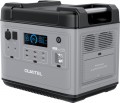USB A (quick charge)
Full size
USB A ports with fast charging support. It allows you to charge your smartphone, tablet or other connected device much faster. The charging process takes place at increased power, and the current and voltage at each stage are regulated in such a way as to remain within the optimal values. However, it should be borne in mind that in our time there are many fast charging technologies and not all of them are compatible with each other.
- The strength of the current. The parameters of the current issued through the USB A fast charging connectors. Note that different voltage and current parameters can be output to different ports of the charging station. This item specifies the current values at a certain voltage (for example, 5 V / 3 A, 9 V / 2 A, 12 V / 1.5 A).
— Power. The maximum power in watts (W) that the charging station is capable of delivering through the USB A fast charging connector to one charging device. High output power allows you to speed up the charging process. However, the appropriate power must be supported by the device being charged - otherwise the speed of the process will be limited by the characteristics of the gadget.
Anderson port
A large two-pole connector for connecting batteries, chargers and all kinds of equipment where reliable contact is required for the sake of ensuring stable operation of the equipment.
Anderson Port is resistant to moisture changes, can be used both for indoor and outdoor mechanisms. Thanks to identical mating parts, a pair is formed by two identical connectors, which are rotated 180 ° relative to each other. Most often, Anderson port is used in mobile homes on wheels.
Battery capacity
Nominal
battery capacity, in fact - the amount of energy that is supposed to be stored. The larger it is, the longer the battery life of the charging station will be, all other things being equal. On the other hand, this parameter also affects the dimensions, weight and price of the battery, despite the fact that an energy-intensive battery is not always required. By the indicator of capacity in watt-hours, you can compare batteries with each other.
Charging cycles
The number of charge-discharge cycles that the battery can withstand without significant loss of performance.
In the process of operation, the batteries wear out, which causes their performance to suffer (in the first place, the capacity decreases). Battery life is usually measured in charge-discharge cycles. However, models with the same declared resource are not always equally durable in practice. Different manufacturers may interpret “significant loss of performance” in different ways: for example, one brand indicates the resource up to a 20% decrease in capacity (DOD > 80%), another - up to a 60% decrease (DOD > 40%) Behind the abbreviation DOD worth decoding Depth of Discharge, i.e. discharge depth. Therefore, when choosing, it makes sense to focus not only on pure numbers, but also on other sources - test results, reviews, etc. Also note that battery life can be noticeably reduced if the operating conditions are violated (for example, in case of overheating or hypothermia).
Charging time (socket) ≈
Time to charge the portable power station from a fully discharged state to 100% charge when using the power adapter from a household outlet. This refers to the original battery and standard charger.
Operating temperature
The temperature range in which the charging station normally operates in normal mode. Exceeding the specified norms in any direction leads to a rapid discharge of the battery, its accelerated degradation and other unpleasant consequences.
Warranty
Warranties for charging stations usually provide users with protection against manufacturing defects and malfunctions for a certain period, which may vary depending on the manufacturer. Warranty service includes free repair or replacement of components if the problem is not the user's fault. The warranty period can be from one year to several years, and it is important to consider conditions such as correct installation, use of the station for its intended purpose, and compliance with technical requirements.

